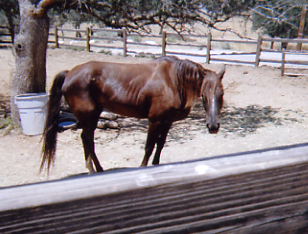
April 2005 – Ellie soon after arriving at Omni-Equus Research Center.
Ellie’s story began as a testimonial on our website. Ellie’s story is important for many horses that could have the same undiagnosed and untreated problem:
Ellie almost died. Ignorance? Neglect? Denial? Who knows? Maybe a little of all of these. I have no desire to blame any one person or institutions – only to share our journey and road back to health that Ellie endured. Maybe Ellie can save another horse from the same fate.
From the time that Dr. Cheri Lewis was successfully riding Ellie (lightly), the weather, the feeding program, and old problems began to resurface.
2004-2005 was one of the wettest winters in Southern California. It was acclaimed as worse than the El Nino year. Like many horses, Ellie did not have a shelter or wear a blanket. At the time, she was refusing to move around and exercise. The weather made any hand walking or riding a treacherous undertaking. Ellie’s caretakers decided not to feed her hay at the scheduled meals with the rest of the horses. Instead, Ellie and her 30-year-old companion were permitted access to the hay pile and could free choice hay at will.
Unfortunately, nobody told Ellie. She was, however, heavily supplemented with sweet feed, multivitamins, and other supplements, which she wolfed down.
I had a difficult time keeping our scheduled bodywork sessions due to the heavy street flooding which cost me work regularly that winter.
When I did make it to Ellie, I noticed she was dramatically thin, eating trees, depressed, cold, and too sore to walk. This was a drastic change from the Ellie we had achieved only months before. Her caretaker assured us that she had mountains of food and just could not keep weight on. Clearly, in their eyes, it was Ellie’s problem.
Cheri kept calling asking me to work on Ellie. “Something’s wrong!” Each time she looked worse. We were assured she was adequately cared for. It was a mystery. What else could anyone do? In everyone’s eyes, everything that could be done for Ellie was being done.
Finally, I arrived to work on Ellie only to find Ellie so weak she could barely stand. I was just as confused as everyone else. She was in obvious pain. During the session, I noticed the worker was feeding all the horses. Both Ellie and her skinny pasture mate stood quietly while all the other horses nickered in their excitement to be fed breakfast. Neither Ellie nor her friend expected to be fed. Both were seriously thin and the weather was still cold.
I’d had enough. I called Cheri and told her what I had seen and advised her, “If you don’t get her out of there now, she’s going to die. Moving her anywhere has to be better than this. For whatever reason, it’s not working.”
Two days later, I received a call from Cheri. “I’m thinking of sending Ellie up to you.”
Although I was already up to my limit with horses, I never hesitated in saying, “bring her up.”
My biggest worry was whether or not Ellie could handle the long 3-hour ride though twists and turns and hills of the remote area in which I live. I recommended a hauler I knew that could be trusted and who knew horses: Fay Ellison
Ellie arrived. Emaciated, weak, covered in sweat and stressed. She could hardly walk to the corral stall I prepared for her. I also placed a cute little gray Arab gelding next to her for company. That turned out to be a hit. Ellie liked the boys and she still has a thing for Fuego.
My plan was to keep her in for a few days and let her relax and get used to the country environment with all the new smells. Eventually, she could go out in the pasture with whoever she could be compatible and safe with.
Two days later, Ellie got a new stallmate. Fuego was bumped back in with the boys (loudly complaining!) and a new big warm-blood mare came in and took up residence next to Ellie. Geneve only likes girls and the two hit it off immediately. The following day, I separated the boys to allow Ellie and Geneve to go out into the pasture. Geneve became Ellie’s surrogate mother and protector. She loved her.
There were many red flags about Ellie. She could barely walk, obviously in pain. I suspected her feet and have always hated the condition of her feet. The other thing was that when you put hay in her stall and led her back into it after her day of pasture, Ellie did not recognize that she had dinner. For breakfast, I would toss hay in and she would hang her head and begin nibbling her bedding. I had to literally go into her stall, pick up the hay and put it in front of her nose – then she would eat and what an appetite she had! Therefore, I free choiced her on 3 way, some alfalfa that she did not prefer and beardless barley. I also put her on 2 grams of bute/2x a day mixed with a small coffee can portion of bran mash and a coffee can of seven feed.
That began my routine. Next step was my Ferrier, Steve Karshner. Steve has proven himself extremely knowledgeable about founder and laminitis and has successfully brought horses “back from the dead” through his natural barefoot trim.
Steve set his own foot rehabilitation program for Ellie. Ellie was put on an every other week foot trim. I watched Steve carve out the most disgusting dead hoof and while there was dramatic improvement in ellie’s movement, she was still in pain and I kept up her bute program (now only 2 grams a day) knowing that I had to get rid of the inflammation in her feet.
Steve began to question the way Ellie was standing, sucking up her gut. I began to question whether she had ulcers to add to her list of problems. I called the vet and put her on Maalox (60cc or 2oz. a day).
Now in comes our wonderful vet, Dr. Chris Comeau. Dr. Comeau has a meticulous creative mind open to new ideas and an attitude of leaving no stone unturned. Steve and I laid out the facts and Dr. Comeau introduced his portion of Ellie’s program.
First came x-rays of Ellie’s front feet. Yes, she had foundered. Possibly before this recent bout as well. While Chris felt Ellie had come through the worst of it, her angles and feet needed some serious adjusting and armed with x-rays, vet consultations, and the vet, himself, Steve dramatically aligned Ellie’s hoof angle to the coffin bone.
There was still obviously a problem with her back feet but we could only deal with her feet in stages.
Dr. Chris and I decided to seriously go after the gastrointestinal irritation since Ellie needed to be on so much bute. Chris prescribed and brought me a big tub of horse formula Maalox called “NeighLox”. Now we had a medicine and a feed program that Ellie liked and seemed to work for her. The small amount of bran kept her bowels moving (since she wasn’t moving around as much as I liked), the senior feed kept her nutrition up and a slow weight gain happening. The 2 grams of bute kept her pain down and the NeighLox kept her insides comfortable.
Next came the back feet. We all decided that it appeared she had foundered in all four feet and we needed x-rays for her hind feet as well as the front. Sure enough, the founder problem was even worse behind and a plan for major feet work was hatched.
Dr. Chris, Steve, and I set an appointment for Ellie. Viewing the x-rays, Chris felt she may have white line disease and a mild form of foot surgery would be in order.
Meanwhile, all this had been ongoing for approximately four months. Winter began to loom on the horizon. The hot muggy days gave way to cold nights and Cheri and I agreed Ellie should not have to go through the mountain winter up here.
Now the pressure was on to get Ellie’s feet stabilized and a program for the future solidly in place to bring her safely down to Los Angeles, where she could be dry and warm and loved by her owner.
Through all of this, I did my deep tissue bodywork sometimes daily. Her pelvis would move out of socket from her, restricting her hind end and every muscle would be overly tight from the stress of her discomfort. I planned to continue her bodywork program once she was in Los Angeles.
The last session with Ellie was the combined efforts of Dr. Comeau and Steve Karshner, the farrier.
Using the x-rays as a guide, it was decided that Ellie’s front feet were just about perfect. Her back feet were now the main focus. According to the x-rays, Ellie’s back right hind foot showed a dark area behind the hoof wall. Operation “Cut Into Hoof” began and there was old, rotten, dead hoof eaten away by bacteria.
Steve and Chris both worked on carving the black decay away and drilling into the hoof to remove every bit of the decay. Ellie’s hoof looked like a big animal took a bite out of it.
The x-rays were the maps to ensure that they did not drill into the coffer bone. After the job was accomplished, Ellie’s foot was coated in tea tree oil to kill the bacteria, her foot was loosely wrapped in gauze, and an easy boot put on to protect her hoof – then loosely wrapped again with tape over the easy boot to keep any debris from getting caught inside the boot.
We all gasped as Ellie walked away. It was the closest thing to soundness we had seen with her.
Congratulations all around. Ellie was a huge success.
Today, Ellie has returned to her “owner – mother”, Dr. Cheri Lewis. She lives in a soft, cushy stall, up to her knees in shavings.
Her first daughter, now Cheri’s main riding horse, is housed across from her mother, Ellie. Both mares know they are mother and daughter.
Ellie’s people follow our program and Ellie is now hand walked. I work on her every week to keep her body comfortable through the rebuilding of her body and her strength.
I cannot tell you how happy I am to see this beautiful, sweet mare, (almost on the edge of dying) returned to a new life, comfortable and happy once again.
Ellie has a new farrier who has added his own expertise and experience that has been in valuable. He has uncovered even more dead rotten hoof that did not show up on the x-rays and continued to cut it out.
Ellie continues to improve and the entire process of removing dead hoof, re-growing new hoof and keeping everything healthy is a slow process.
This has been an incredible learning experience for us all.
9-23-05
